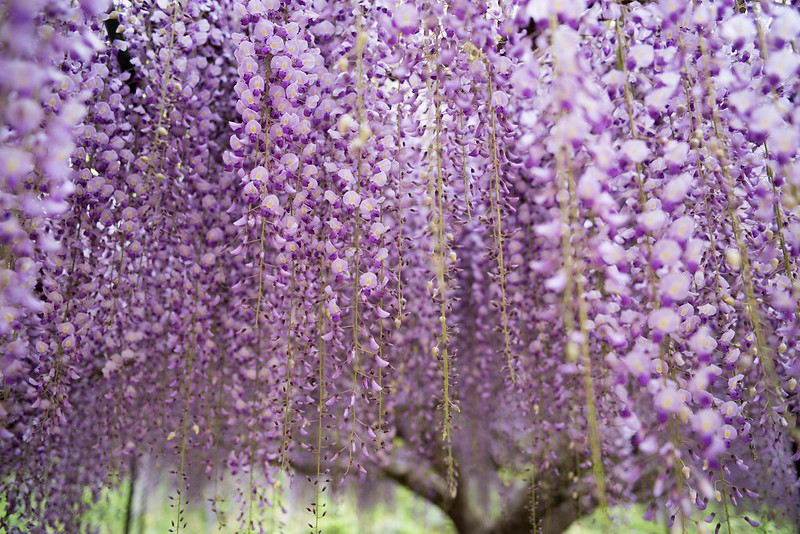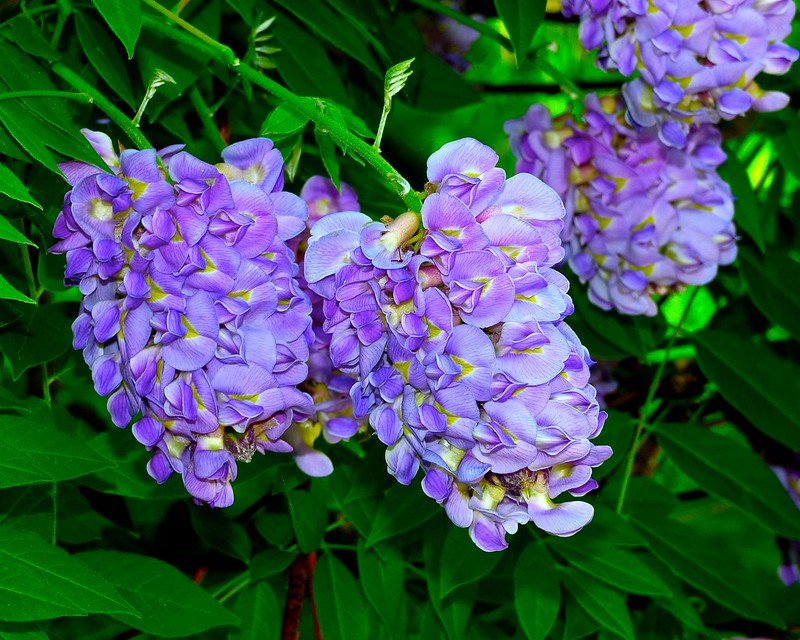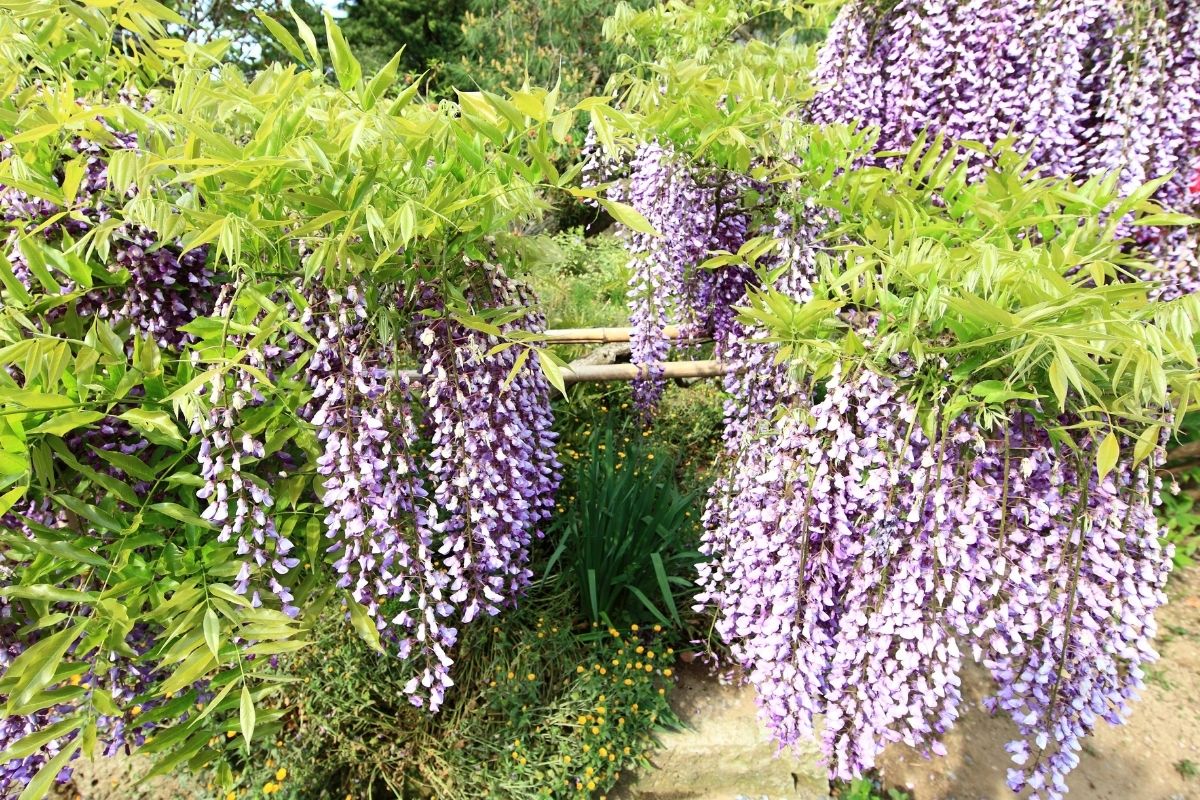Wisteria plants are a beautiful way to add natural whimsy and beauty to your garden, through any season. In the springtime, they are a lush green, with new, baby leaves sprouting.
In the summer, they are completely filled with oodles of colorful, grapevine like blooms, letting off a beautiful heady smell of summertime.
During the fall, their leaves begin to turn a yellowy copper, filling your garden with beautiful, autumnal colors.
In winter, after all the leaves have fallen, you will see the nearly magical looking twisty bare branches of the plant, and see how it is climbing up any structure that you have put it near.
You get the picture – they are a great addition to your garden, and look great regardless of the season.
But – this is where your problem arises – the wisteria plant is so popular that there are a lot of different varieties on the market, and it van seem like a maze picking the right variety for your garden.
Thankfully, this article is here to help.
We will guide you through the different kind of wisteria, their appearance, and their preferred conditions, so you have all the right information to choose the right fit for the location that you have in mind. Read on to learn more!
1. The Japanese Wisteria

The Japanese wisteria (which has the Latin name Wisteria floribunda) is a vigorous, deciduous climbing plant, which has pinnate leaves (i.e., a leaf which is divided into smaller leaflets, which are in turn arranged on each side of the leaf’s central stalk/axis/rachis).
The Japanese variety of wisteria produces showers of fragrant, sweet pea like flowers in early summer, on racemes (which are vine like strips) of up to 30 cm in length.
Generally, these flowers come in colors like violet, blue, lilac, pink and white.
When it reaches maturity, this plant can be anywhere from 10 to 30 feet in height, and sometimes may be even taller if it has been put in the right conditions.
The Japanese wisteria is a great choice if you live in zones four to nine, as it is a really reliable choice for gardeners in northern climates.
It also offers you the greatest variety in colors, so you’re choosy when it comes to aesthetics, then this is a great pick.
You can even graft two wisteria plants together, so that you get a single plant producing multiple colors of blooms.
If you are interested in cultivating your own Japanese wisteria, then there are a few factors to consider.
Because it is a long-lived climber, you have to choose the right location for it – you want somewhere where you can appreciate is beauty and gorgeous scent, without it getting obstructive.
It will thrive against a pretty solid structure to grow around – you can grow it informally against a large tree, or more formally against a wall of your house or garage.
You can even train it to be a freestanding half standard tree in a pot or container – basically, the world (or rather, the garden) is your oyster with this one.
2. The Chinese Wisteria

The Chinese wisteria (which is also known as the Wisteria sinensis, and the Chinese kidney bean) is a large, deciduous climbing tree, which has twining, twisted stems, and has dark green, pinnate leaves.
It produces mauve or lilac colored flowers, in drooping cones of racemes, which are about 30 cm in length on average.
When comparing the Chinese wisteria with its Japanese counterpart, the Chinese wisteria typically has shorter clusters of flowers, and is not as hardy to frosts and droughts.
It also flowers at a different time, being in full bloom from early spring to early summer.
All of the flowers in a cluster/raceme will open all at once, before the foliage even appears. The flowers bloom gradually over a period of a few weeks, and will last longer than other kinds of wisterias.
If you want to put a Chinese wisteria into your garden, then you should choose a spot that gets either full sun or partial shade, and is south or west facing (but still remains quite sheltered).
It thrives in zones five to eight, and a reach a height of 25 feet when fully mature. It can be trained horizontally, for a more standard tree look, or the branches can be spread out, so it looks more like a matt of vines/foliage covering a wall.
3. The Silky Wisteria

The silky wisteria (also known as the Wisteria brachybotrys), is another kind of Chinese wisteria, and is a deciduous climbing tree, which twines anticlockwise.
When mature, it can have a spread of over 9 m, making it a good choice if you have a lot of space to fill.
The leaves consist of 9 to 13 oval shaped downy leaflets, which gives the plant a lush, full look when covered in foliage. It will produce slightly fragrant violet, blue, or white flowers.
Out of all of the wisterias, it produces the smallest flower racemes, at 10 to 15 cm in length, and they are the least fragranced, which is great if you are very sensitive to fragrance, and don’t want to be overwhelmed.
The blooming will get stronger year on year, both with age and with good pruning, for this wisteria. It gets its name from the silky hairs that it has on the foliage, giving it a soft to the touch feeling.
If you want to add this smaller variety of wisteria to your garden, then you should place it in a position with well draining soil, in full sun or semi shade conditions.
You can train it to climb into a large tree, up a wall, on an arch, or up a pergola. Like other varieties of Chinese wisteria, it grows best in zones five to eight.
4. The American Wisteria

Unlike other wisterias that feature on this list, the American wisteria (which has the Latin name Wisteria frutescens) is native to the Eastern region of the US, mainly growing in the Carolinas, and along the East Coast.
It produces blue, purple, and white flowers during the spring and summer time, and as it is native to the US, it is hardy through zones five to nine.
Visually, this is the least impressive of all of the wisteria plants, as it doesn’t produce long racemes of flowers. Rather, it produces small clusters of flowers that have only a light scent.
However, it does have a lot of appeals – it is not as fast-growing as other kind of wisteria, and it isn’t invasive.
Therefore, because of its more controlled way of growing, it’s a great option if you have limited space in your garden, and already have a lot of plants competing for the same spot.
When mature it will reach an impressive 20 to 30 ft tall, although this will take quite a number of years, and you might not even get flowers for the first 5 to 6 years of having this vine in your garden.
If you are thinking of growing an American wisteria in your garden, make sure that you put it in an area that gets full to partial sunlight, and has moist but well-drained soil.
It also prefers acidic or neutral soil pHs as opposed to more alkaline soils
5. The Kentucky Wisteria

The Kentucky wisteria (which has the Latin name Wisteria macrostachya) is a woody, deciduous vine, native to the southeastern region of the United States.
It is really similar to the American wisteria plant. The Kentucky wisteria plant will produce racemes of flowers that are 15 to 30 cm long.
It will flower after only a two or three years, making it the speediest wisteria to flower.
In spite of these blooming differences, it has requirements, behavior and characteristics which are all very similar to the American wisteria.
This is also the most cold hardy kind of wisteria, making it suitable for growing in hardiness zones three to nine, and because of this, it has the latest bloom time, with flowers typically emerging around June.
However, it will likely rebloom throughout the growing season, making it a great choice for a splash of summer color.
How To Select The Right Kind Of Wisteria Plant For Your Garden?
Generally, when you’re choosing between different types of wisteria, it often boils down to their aesthetic appeal, and their commercial availability near you.
The two kinds of wisteria that are most commonly grown in the US are Chinese and Japanese wisteria.
This is because they have showy displays of flowers throughout spring and summer, in a range of colors.
They also produce a strong, appealing sent that has become associated with a healthy garden in the summer time.
However, these grow more aggressively, and even considered an invasive species in some regions.
Native species of American wisteria are a tamer plant. They are a more slow-growing and a bit less likely to overrun your garden, while still offering the same lush beauty and periwinkle colored flowers.
If you are thinking of buying yourself an American wisteria, look for specialist online mail retailers, as they can be a little bit hard to find at local garden center.
Now that you know about 5 types of wisteria plants & how to select the right kind for your garden, make sure to check out our other articles:







